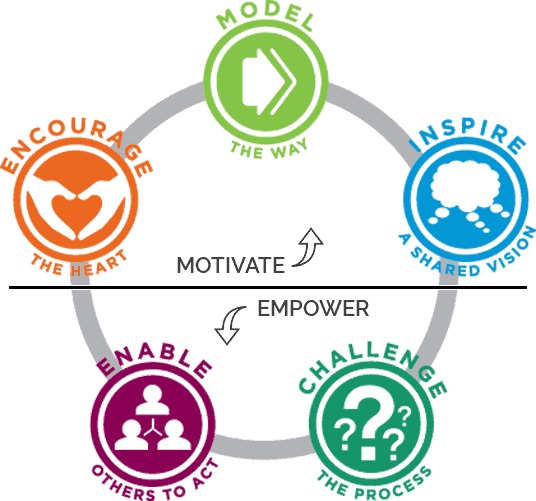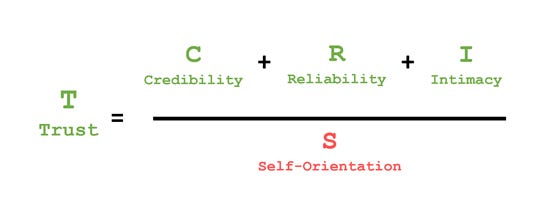5 Levers of Influence (5/5): Example
Developing your influence has 5 different levels, today we are going to talk more about the last one in the series: being an example.
This series of articles about influence started with the introduction to The 5 Levers of Influence, check it now:
So we have “The 5 Levers of Influence”:
Credibility: No one listens to noise. They follow competence and consistency.
Relationships: Influence spreads at the speed of trust.
Communication: You can't lead if your ideas don’t land.
Shared Goals: Influence is easier when people care about the same outcome.
Example: You can’t fake integrity. People watch what you do.
And today, we will dive deep into item number five on the list: Shared Goals.
If you’re not a subscriber, you can still grab DDL’s free guide Leading Better 1:1s. It’s packed with questions, feedback tips, and a simple roadmap for better 1:1s.
✅ Reflective questions (Quiet Leadership style)
✅ Feedback prompts (Radical Candor made practical)
✅ A simple step-by-step conversation roadmap
What You Do Is Louder Than What You Say
He said all the right things in the meeting. Spoke clearly. Aligned the team.
Explained why quality mattered. And it sounded honest.
You could feel he believed in it. He wasn’t pretending.
But then, just two days later, someone noticed he skipped the final review.
Quietly. No announcement. Just skipped it to meet the deadline.
When asked, he said, “Only this once, to solve a customer's urgent thing.”
Nobody said anything. But something shifted…
Next sprint, more things were rushed. Fewer questions were asked. And that strong message about quality? It started to fade.
Not because the team didn’t understand. But because they were following his behavior.
That’s what many leaders miss. You can communicate clearly, speak about values, and even build trust.
But if your actions don’t match your words, your message breaks.
And here’s the hard part: most of the time, people won’t say a word.
They’ll just stop believing. Or worse, they’ll copy the wrong example.
There’s this idea, especially in digital leadership, that if we explain things well enough, the team will adopt the mindset.
But people don’t adopt mindsets by hearing them. They adopt them by watching you live them.
Albert Bandura showed this decades ago. His research on Social Learning Theory proved that people learn by observing others, especially those in positions of influence.
Teams learn the culture by watching what’s normal. Not what’s written in the slides. What’s repeated in behavior?
And what do they watch most closely? Your behavior under pressure. Your habits when you think no one will notice.
That’s when your real leadership shows up. Or falls apart.
Let me give you a simple example from my own work. In one project, I kept saying that documentation was important. I even added it to our checklist.
But every time we got close to a deadline, I was the first one to ignore it.
No time, I thought.
We’ll add it later. But of course, we never did. And soon, the whole team stopped bothering with it, too.
Not because they didn’t care. But because they were following what I did.
Not what I said.
That’s when I realized something simple and hard at the same time: influence is built through habits. Not speeches.
This lever — leading by example — is not about being perfect. It’s not about image. It’s about the small signals you send every day.
The ones that either build trust or quietly break it. Kouzes and Posner call it “Model the Way”.
They found that people follow what you show them is important, not what you tell them is important. And this matters even more in digital teams, where priorities are always shifting and pressure is high.
Your behavior becomes the map others use when things get confusing.
That means you’re always setting a standard, even if you don’t mean to.
You show what’s okay when you cut a corner. Or when you treat a stakeholder differently from your team. Or when you stay quiet during a tough conversation. It doesn’t look dramatic. But it shapes the room.
Here’s the uncomfortable truth:
People don’t copy your best version. They copy your most frequent version.
So if your habits are inconsistent, your team learns that inconsistency is fine. And soon, what you repeat becomes permission.
We’ll go deeper into this next. But for now, just pause and ask yourself:
What am I showing them, day after day, moment by moment?
Because leadership doesn’t live in the all-hands presentation, it lives in how you show up on a regular Wednesday morning.
And even when no one is talking about it... They’re watching. Always.
The Example Breaks Quietly, Not Loudly
We often think influence disappears in big, dramatic moments.
A huge failure…
A public mistake…
But that is not what usually happens. In most teams, trust doesn’t break all at once.
It fades… Slowly... One small contradiction at a time.
You say transparency matters. Then you skip your own update.
You say you welcome feedback. But when someone disagrees with you, you go silent.
You say accountability is important. But your own deadlines keep sliding, and nobody says anything.
These things rarely lead to a confrontation.
People don’t always name them out loud, but they notice. And over time, they collect those moments and quietly think, “Maybe I can’t count on this person the way I thought I could.”
Let’s talk about what causes this slow erosion of influence.
These aren’t extreme behaviors. But that’s exactly what makes them dangerous, they are easy to ignore, and easy to repeat.
Saying one thing, doing another
This is the most common mistake. And still the most powerful one.
When your actions do not match your words, people always trust your behavior, not your message.
You can’t say “meetings must start on time” and then arrive late.
You can’t ask for honesty and then shut down when someone challenges you.
People listen to what you tolerate. Not what you say.
Acting differently when the room changes
Some leaders show one version of themselves in front of executives and another with their team.
The shift might be small, a different tone, a different energy, but the team feels it.
And they start to wonder, which version is real?
Only leading when things are easy
It’s easy to talk about values when everything is going well.
But leadership shows up when the project fails, when a client is angry, or when the roadmap just breaks.
If you only model your values during calm days, people will assume those values are for show.
They want to see who you are under pressure.
Letting emotions lead, then never returning to fix it
Everyone has bad days. That is not the problem.
The problem is when you take that frustration out on your team and never address it afterward.
The silence after the storm becomes part of your leadership story. And it leaves a mark. Your calm later matters more than your anger in the moment.
What people want from a leader is consistency.
A feeling that your actions match your words, even when it’s hard… Especially when it’s hard.
When people see that kind of behavior over time, they begin to trust you. And once trust is built, they don’t need reminders or rules. They choose to follow.
Not because they have to. But because they believe in you.
Because in the end, your leadership is not measured by what you say on a slide.
It is measured by what you do when no one is watching.
What the Science Says
We all like to believe that if we say the right things, people will follow.
If we explain the plan clearly, speak with confidence, and show excitement, others will trust us and act accordingly.
But in real life, that’s not always true. People don’t follow instructions. They follow examples. And they don’t always follow the person with the best ideas.
They follow the one whose behavior feels real, consistent, and safe to copy.
That’s not just a personal belief. It’s backed by decades of studies in psychology, neuroscience, and leadership.
These studies show something we often forget in daily work: people learn by watching. They make decisions based on what they see, not just what they hear. And even when they trust your words, they still watch what you do to decide if they believe you.
Albert Bandura's Social Learning Theory is one of the most important studies in this space.
He found that people learn much more by observing others than by being told what to do.
Think of how kids learn, they copy adults without needing detailed instructions. But it’s not just kids.
Adults do it too. We watch how people behave and then adjust our own behavior to fit in. This happens especially in teams and workplaces.
If your manager ignores problems, others learn to stay quiet. If your teammate always delivers sloppy work but still gets praised, others learn that quality doesn’t really matter.
This idea means something big for leadership. It means you're always teaching, even when you don’t mean to. People are learning from your choices, your tone, your silence, and your stress.
You don’t need to say, “This is how we do things here.” They’ll just copy what you do.
Mirror neurons give this idea a biological explanation. These are parts of our brain that automatically reflect what we see in others.
If someone near us is smiling, we tend to smile too. If someone is stressed, we feel tense without even knowing why.
These neurons help us connect emotionally with people, and they help us learn behaviors by copying them. In short, we don’t just see others, we feel what they feel.
This is why leadership is emotional. When you stay calm under pressure, you help others stay calm. When you panic, others get nervous too.
When you treat someone with kindness in a hard moment, others learn that kindness is allowed.
But if you shut down, explode, or ignore someone’s feelings, your team learns that emotions are unsafe. And once people feel unsafe, they stop showing up with their full selves.
They don’t even know why; their brains are simply mirroring yours.
Kouzes and Posner, in their book The Leadership Challenge, wrote about a principle they call “Model the Way.”
They say that people decide who to follow based on who shows consistency between what they say and what they do.
If your behavior matches your words, people trust you. But if there's a gap, if your actions say something different, trust disappears quickly.
Not because people are being difficult, but because they’re confused.
They don’t know which version of you is real.
This is why credibility matters so much in leadership. It’s not about being perfect.
It’s about being steady. People need to believe that your values are real, especially when things go wrong. Anyone can talk about respect or integrity when things are easy.
But when the deadline is tight, or someone messes up, or a stakeholder is frustrated, that’s when your team watches closely.
If you stay fair, honest, and respectful in those moments, your example becomes strong. If you don’t, your words lose meaning.
Amy Edmondson’s research on psychological safety gives us another important insight.
She found that teams perform better when people feel safe to speak up, ask questions, and admit mistakes.
But this safety doesn’t come from saying “don’t worry” or “it’s okay to fail.”
It comes from behavior. People feel safe when they see that mistakes are treated with curiosity, not blame. When feedback is taken seriously, not punished. When leaders stay kind under pressure, not cold or reactive.
This matters because teams don’t just need goals. They need space to be human.
If someone is scared to admit they’re behind or worried they’ll look stupid for asking a question, the team loses speed.
Not because of skill, but because of silence. And silence doesn’t come from laziness.
It comes from watching how their leader reacts when things get uncomfortable.
If you want a team that communicates well, you have to show them how that safety looks in action.
David Maister's Trust Equation adds another helpful way to think about this.
He explains that trust is made of four things: credibility (what you know), reliability (what you do consistently), intimacy (how safe people feel with you), and self-orientation (whether you care more about others or yourself).
These parts work together. You can be smart and reliable, but if people feel like you're only helpful when it benefits you, trust starts to break. And once that happens, influence disappears quietly.
You don’t need to act selfishly to lose trust. Sometimes it’s small things, taking credit without giving thanks, pretending to listen but rushing off, being present in meetings but distant in follow-ups.
When these things repeat, people feel like they’re being managed, not supported.
They may not say anything. But they stop trusting your intentions. They start doing the minimum. They stop sharing risks or new ideas. And they protect themselves instead of connecting with the work.
Do you want to unlock many more systems to become a better leader? Subscribe now and get 20% off your first year
Paid subscribers unlock:
🔐 Weekly premium issues packed with frameworks and/or templates
🔐 Access to special toolkits (check the Starter Kit already available below)
🔐 Strategic guides on feedback, influence, and decision-making
🔐 Exclusive content on career growth, visibility, and leadership challenges
🔐 Full archive of every premium post
Plus, you get a Starter Kit when you subscribe, which includes:
🔓 Feedback & 1:1: Meeting Templates, Feedback Cheat Sheet, Conversation Scenarios
🔓 Stakeholder Management & Influence: Stakeholder Power Map, Expectation Tracker, Influence Playbook, Communication Templates, Conversation Planner
🔓 Weekly Planner: Weekly Planners A & B, Time Audit & Meeting Review, Start / Stop / Continue Reflection, Leadership Focus Reset, 33 Activities for Weekly Planning
Keep reading with a 7-day free trial
Subscribe to Decoding Digital Leadership to keep reading this post and get 7 days of free access to the full post archives.













